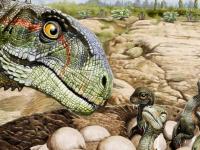How Long Did The Dinosaur Extinction Last?

What time scale would the extinction of the dinosaurs happened over? Weeks or months or centuries?
How long did the dinosaur extinction last? We asked Geologist John Underhill to weigh in...
John - Well, let's go back to when it actually happened. So the mass extinction event actually wiped out three quarters of animal and plant species at the Cretaceous-Tertiary boundary called the K-T boundary.
Chris - How do you know?
John - Well you look at the fossil record beforehand and immediately thereafter in the strata that are displayed and you see the changes that occur over that. That happens around 66 million years ago going back to the radioactive decay and dating of the earth and so on, and it's actually marked by a tremendous concentration of an unusual mineral called iridium. We don't actually find it in the UK, so we have to look elsewhere for the actual golden bullet, if you like.
Chris - It's like a signature. You're saying that written into the strata, which we can date, is this mineralogical fingerprint if you like?
John - That's right, although not present in the UK. Even recently in the last couple of weeks there have been good reports about North Dakota and some of the samples in that particular area.
Chris - So are you saying then that this stuff is not naturally found on Earth, therefore it came in with whatever 'did' for the dinosaurs because we can see it appearing at the right point in time when we know that event is likely to have happened?
John - So there's certainly an event, that's definitely right. And this is where we get to the nub of the issue because we can date an impact crater. We can identify one in northern Mexico, a place called Chicxulub, and it's located beneath the Yucatan Peninsular and it appears to be the smoking gun, if you like for the iridium.
Chris - How big is the crater?
John - The crater is tens of kilometres across. It caused massive instability in the continental shelf in northern Mexico.
Chris - So how big would the thing that came in have to have been to have made a crater that big?
John - Of that size. I mean, it's the size that you see on the Moon with some of the craters there and so on. But whether it was actually the golden bullet that did for the dinosaurs is really coming back to the nub of the question that has been asked. Because there is another possibility in terms of what caused the toxic atmosphere at that time and that is actually major eruptions, what are called the Deccan Traps in India which occurred over a period of 66 to 65 million years ago. And one of the interesting things about this particular event is, of course, about 150 to 200 thousand years after the iridium anomaly we see a number of dinosaurs and other species staggering on beyond the iridium anomaly, and this suggests that actually there may have been a double whammy that 1) you had the meteorite impact, but moreover the toxic atmosphere was actually being created by the volcanic debris and the like that was going up into the air, and that makes it more consistent with other mass extinction events through the rock record, which have all been tied back to large igneous provinces. So it's probably the two things together. And to answer the question: it was tens of thousands of years, not instantaneous.
Source: www.thenakedscientists.com








